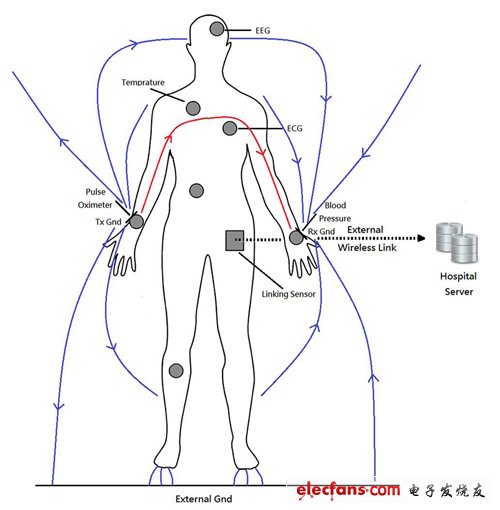A major design breakthrough has occurred in the intelligent medical monitoring system. With the finalization of the IEEE 802.15.6 technical specification for the human body area network, the new generation of medical care systems will wirelessly transmit physiological signals measured by wearable sensors in various parts of the human body to the hospital server and store them to provide real-time Intelligent functions such as remote monitoring and patient physiological status analysis.
As the global population ages and the population of chronic patients increases, remote home care has become an important issue in the development of medical care in advanced countries. At this stage, there has been significant progress in the measurement of physiological parameters. By combining portable sensor devices and the Body Area Network (BAN), medical staff will continuously monitor and analyze the physiological signals of patients to give Correct health guidance, consultation and tracking of patients; meanwhile effectively reduce the waste of medical resources and improve the quality of medical treatment.
Human body area network technology helps modern medical system function upgrade
Traditional medical care requires medical staff to monitor the physiological signals of patient sensors from time to time, making the nursing staff exhausted. The modern medical care system allows the nursing staff to remotely monitor and analyze the patient's physiological signals in real time through the human area network technology. If the patient is in critical condition, the medical staff can also immediately know and make emergency treatment.
The human body area network is composed of multiple sensors (EEG, ECG, etc.), distributed on the patient's body to collect and transmit physiological signals (Figure 1). The physiological signals of all sensors are collected by connected sensors (watches or other portable devices), and the physiological signals of patients are transmitted to the server of the hospital through external wireless networks (WLAN, WWAN) and stored. Allow medical staff to monitor and analyze the patient's physiological signals in real time to reduce the use of medical resources.

Figure 1 Schematic diagram of human medical monitoring network
The human body area network can be applied to close-body wireless sensing technologies such as human physiological signal monitoring or multimedia entertainment. At present, the IEEE 802.15.6 Task Group has begun to develop human body area network specifications and define three physical layer methods, including narrow frequency ( Narrow Band), Ultra Wideband (UWB) and Human Body Communication (HBC).
Among them, human body communication uses human body channel transmission as the physical layer medium, which can reduce transmission power consumption, so its energy efficiency has advantages over narrow frequency and ultra wide frequency. In order to increase portability and save power replacement costs, it is necessary to use thin and light thin-film batteries, or use energy harvesting and regeneration (Energy HarvesTIng) to provide power, and even supply power by recovering the energy received from wireless signals. Therefore, ultra-low energy consumption is a key focus in the design of wireless human communication systems to extend the battery life cycle.
However, the channel response of human body communication has capacitive characteristics, which will vary with the wearer's age, height, weight, posture, electrode geometry design, and the surrounding environment of the human body.
Since human body communication uses the human body as the communication medium and transmits by means of electrostatic coupling (ElectrostaTIc Coupling), the system only needs a low-complexity digital circuit and electrode pad (replaces the antenna) to achieve. Among them, the transmitting end inputs digital voltage signals to the electrode pads, which converts into electric field conduction on the body surface; when the receiving end electrode pads sense the electric field, they can be converted into voltage signals for reception. It should be noted that both the human body and the sensor must be Grounding can create a loop.
Digital circuits create a human body communication system
In the operation process of the human body communication mechanism, the IEEE 802.15.6 standard is first used to define the frame structure of the physical-layer protocol data unit (PPDU) of the human body communication. The preamble and the frame start symbol (Preamble) Start Frame Delimiter (SFD) / Rate Indicator (RI), physical layer header (PHY Header), and physical layer data load (PHY Payload). The physical layer data payload is composed of a media access control header (MAC Header), a media access control data payload (MAC Payload) and a frame check sequence (Frame Check Sequence, FCS) (Figure 2).

Figure 2 Human communication frame structure diagram
Stainless Steel Square Bar,Stainless Steel Square Rod,Cold Drawn Stainless Steel Square Bar,Polished Stainless Steel Square Bar
ShenZhen Haofa Metal Precision Parts Technology Co., Ltd. , https://www.haofametal.com